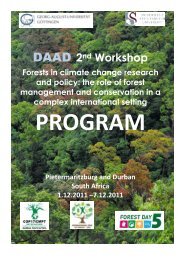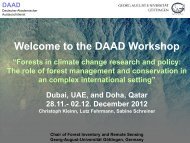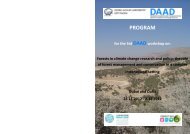Proceedings of the Workshop - Georg-August-Universität Göttingen
Proceedings of the Workshop - Georg-August-Universität Göttingen
Proceedings of the Workshop - Georg-August-Universität Göttingen
You also want an ePaper? Increase the reach of your titles
YUMPU automatically turns print PDFs into web optimized ePapers that Google loves.
Based upon <strong>the</strong> critical state in which <strong>the</strong> TDF ecosystems are found in<br />
Colombia, it is urgent to devote efforts so as to implement strategies focused on<br />
restoration processes in <strong>the</strong>se ecosystems. And in this context, it should be noted that<br />
it will in no way be possible to perform a restoration against <strong>the</strong> will <strong>of</strong> <strong>the</strong> affected<br />
population that is conscious <strong>of</strong> only being kept afloat by a dependence on land<br />
resources (Andres 2009; Galmez & Komett 2009, Barnsley 2009).<br />
Due to drought conditions experienced by dry forests, seed recruitment and<br />
growth rates are affected and are lower than those <strong>of</strong> tropical rainforests. Also, some <strong>of</strong><br />
<strong>the</strong> dry forests are subject to large-scale forest fires due to <strong>the</strong> accumulation <strong>of</strong> not<br />
decomposed, dry organic matter, although <strong>the</strong>re is evidence that <strong>the</strong>se forests are less<br />
prone to such events due to <strong>the</strong> plant adaptations (Vieira & Scariot 2006).<br />
In this sense, ecological restoration aims to restore an ecosystem that has been<br />
degraded, damaged or destroyed, through <strong>the</strong> stimulation and acceleration <strong>of</strong> natural<br />
succession in order to restore <strong>the</strong> forests' ability <strong>of</strong> self-regulation (Rodriguez 2009)<br />
and finally, to allow not only <strong>the</strong> establishment <strong>of</strong> core conservation, but also <strong>the</strong><br />
recovery <strong>of</strong> <strong>the</strong> functionality and environmental services a previously degraded<br />
ecosystem provides or may provide.<br />
This gives great importance to each existing remnant when seeking to preserve a<br />
representative sample <strong>of</strong> TDF in Colombia. Particularly <strong>the</strong> San Sebastian hacienda<br />
has almost 200 hectares <strong>of</strong> forests that have not been touched in at least 40 years;<br />
<strong>the</strong>reby exists a great opportunity in contributing to <strong>the</strong> study and conservation <strong>of</strong> this<br />
type <strong>of</strong> ecosystem.<br />
Given <strong>the</strong> significant emissions from deforestation and forest degradation,<br />
especially in developing countries, several parties have focused <strong>the</strong>ir attention on<br />
creating positive incentives for those countries, so as to reduce <strong>the</strong>ir deforestation rates<br />
and forest degradation (Barnsley 2009). In this sense, emissions from deforestation<br />
and forest degradation in developing countries account for about 20 percent <strong>of</strong> total<br />
emissions <strong>of</strong> greenhouse gases (GHG) annually, and it is precisely in this context that<br />
<strong>the</strong> initiative <strong>of</strong> reducing emissions from deforestation and forest degradation in<br />
developing countries (REDD) is a must (Angelsen 2009). The basic idea behind REDD<br />
is <strong>the</strong> creation <strong>of</strong> a system <strong>of</strong> positive incentives that will persuade developing countries<br />
with tropical forests to reduce deforestation rates, by financially rewarding <strong>the</strong>m<br />
(Barnsley 2009).<br />
Colombian TDF are included in <strong>the</strong> Andean forest ecosystems (EFA) which<br />
according to Etter & Villa (2000) are <strong>the</strong> most diverse and threatened terrestrial<br />
ecosystems, recognized as a major global hotspot and representing a priority for<br />
conservation because <strong>of</strong> <strong>the</strong>ir extraordinary richness and endemism, as well as several<br />
<strong>of</strong> its constituent species being severely threatened (Miles, et al. 2006). In addition to<br />
be a priority for biodiversity conservation in <strong>the</strong> great hosting, EFAs are <strong>the</strong> living basis<br />
<strong>of</strong> populations in surrounding areas, due to <strong>the</strong> multiple social, economic and<br />
environmental resources <strong>the</strong>y provide (Quesada, et al. 2009).<br />
Forestry activities <strong>of</strong>fer an attractive potential for climate change adaptation and<br />
mitigation <strong>of</strong> adverse effects. By promoting conservation <strong>of</strong> forest through management<br />
practices, forest carbon emissions into <strong>the</strong> atmosphere are reduced, helping to mitigate<br />
climate change and its impacts (Galmez & Komett 2009).<br />
In this sense <strong>the</strong> REDD systems have great potential to generate collateral<br />
benefits for <strong>the</strong> conservation <strong>of</strong> biodiversity and o<strong>the</strong>r ecosystem services (in addition<br />
to carbon sequestration). It is considered that tropical forest conservation has been<br />
underfunded in recent decades, both in terms <strong>of</strong> scale and duration <strong>of</strong> <strong>the</strong> funding cycle<br />
(Galmez & Komett 2009). In this sense, <strong>the</strong> financial flows related to REDD <strong>of</strong>fer new<br />
possibilities providing collateral benefits in terms <strong>of</strong> conservation. The ecological<br />
importance <strong>of</strong> <strong>the</strong>se ecosystems is becoming obvious as a source <strong>of</strong> storage and water<br />
sources regulation, since <strong>the</strong>y are a determining factor for soil protection and<br />
‐ 48 -










